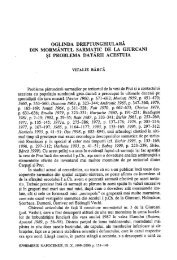EPHEMERIS NAPOCENSIS - Institutul de Arheologie Åi Istoria Artei
EPHEMERIS NAPOCENSIS - Institutul de Arheologie Åi Istoria Artei
EPHEMERIS NAPOCENSIS - Institutul de Arheologie Åi Istoria Artei
You also want an ePaper? Increase the reach of your titles
YUMPU automatically turns print PDFs into web optimized ePapers that Google loves.
Commentaria Archaeologica et Historica (I)<br />
173<br />
were recently ad<strong>de</strong>d those from Hunedoara 52 , or tumuli at Cugir 53 and Călan 54 . During the last two<br />
<strong>de</strong>ca<strong>de</strong>s I have shown that these burials concentrated in south-western Transylvania are later dated<br />
than the Celtic horizon (La Tène B2–C1) in the region. This fact may indicate a northward migration<br />
of a warlike elite from areas south of the Carpathians, which replaced the Celtic domination in<br />
Transylvania and later led to the appearance of the Dacian Kingdom. These burials are located in<br />
the vicinity of some Dacian settlements, sometimes fortified, and the ceramic inventories are local 55 .<br />
The publication of certain ol<strong>de</strong>r and previously unpublished discoveries, as well as the graves<br />
more recently uncovered across the entire area of the Pa<strong>de</strong>a-Panagjurski kolonii group, enriched<br />
the ‘archaeological dossier’ and led to the appearance of some new contributions to this subject 56 .<br />
Archaeological repertoire of Transylvania can be also enlarged through an analysis of the information<br />
concerning ol<strong>de</strong>r discoveries and a re-evaluation of the recent ones, which are further discussed.<br />
The recent publication of the archaeological notes of István Téglás, a collector from<br />
Turda who worked in the second half of the 19 th century and at the beginning of the 20 th century,<br />
facilitated the recovery of some important scientific data. The Turda collector assembled a repertoire<br />
and drew numerous sketches of many artefacts from various Transylvanian collections or<br />
collected by himself from some archaeological sites. A part of these finds en<strong>de</strong>d in some of the<br />
mo<strong>de</strong>rn museums, but others were lost forever 57 .<br />
Amongst the finds which in the last quarter of the 19 th century were in the collection of<br />
Gábor Téglás from Deva (a gymnasium teacher, historian, archaeologist and collector of antiquities;<br />
<strong>de</strong>spite the similar surname the two collectors were unrelated) 58 was a curved dagger discovered in<br />
the same locality and having the morphological characteristics of a sica 59 (Fig. 8/1). The presumably<br />
lost dagger (perhaps it still exist in the ol<strong>de</strong>r collections of the Museum of Deva?) preserved a part<br />
of the scabbard (on about 20 cm of the bla<strong>de</strong>). The total length of the artefact was of 50 cm, being<br />
amongst the largest daggers of this type. The piece from Deva has numerous analogies inthe area of<br />
the Pa<strong>de</strong>a-Panagjurski kolonii group. The shape of the hilt is also encountered on other examples<br />
discovered in graves from Cetate 60 in Oltenia, Târnava 61 and Vinograd 62 in Bulgaria, all of them being<br />
dated to the LT D1. The perfect state of conservation, according to the drawing ma<strong>de</strong> by I. Téglás,<br />
as well as the presence of the scabbard, suggests that the dagger probably belonged to a funerary<br />
52<br />
SÎRBU/LUCA/ROMAN 2007.<br />
53<br />
CRIŞAN 1980; RUSTOIU 2008, 161–162, Fig. 81.<br />
54<br />
RUSTOIU/SÎRBU/FERENCZ 2001–2002.<br />
55<br />
RUSTOIU 1994a, 35; RUSTOIU 1994b; RUSTOIU 2002, 25–40; RUSTOIU 2005; RUSTOIU 2008,<br />
142–163 etc.<br />
56<br />
ŞERBĂNESCU 2006, 168–171; TORBOV/ANASTASSOV 2008; ANASTASSOV 2011, 230–231 Fig. 11–12;<br />
BONDOC 2008; BONDOC 2008–2009 etc. See mostly ŁUCZKIEWICZ/SCHÖNFELDER 2008, with important<br />
comments regarding the entire phenomenon. The recently recovered artefacts coming from <strong>de</strong>stroyed graves from<br />
Hrtkovci, in the vicinity of the Scordiscian settlement at Gomolava (a sword, a curved dagger <strong>de</strong>corated with face-to-face<br />
birds of prey on the bla<strong>de</strong>, spear heads, a ‘Thracian’ horse-bit, chariot parts similar to those discovered in tumulus 2 from<br />
Cugir, late Republican bronze vessels etc), can be ascribed to the Pa<strong>de</strong>a – Panagjurski kolonii group. They illustrate the<br />
westward extension of the authority of the Dacian Kingdom un<strong>de</strong>r Burebista. See DAUTOVA RUŠEVLJAN/VUJOVIĆ<br />
2006, Fig.: 24; 29; 50; 52–53; 54; 63 etc, with numerous errors regarding the dating and cultural i<strong>de</strong>ntification.<br />
57<br />
BAJUSZ 1980; BAJUSZ 2005.<br />
58<br />
See WOLLMANN 1983, 262; RUSTOIU 1991.<br />
59<br />
BAJUSZ 2005, 134 no. 69, Fig. 18/141/3. During the last years several curved knifes from pre-Roman Dacia<br />
were published, completing the repertoire of discoveries. Still, some of these pieces are not curved daggers from a<br />
morphological and functional point of view. For example amongst the artefacts coming from Sălaj, and published by<br />
POP/BORANGIC 2009, only the piece from Şimleu Silvaniei (op. cit., Fig. 2/1) is a true sica. For the morphology<br />
and functionality of the curved daggers see RUSTOIU 2007a.<br />
60<br />
NICOLĂESCU-PLOPŞOR 1945–1947, 19, Pl. 3/6.<br />
61<br />
THEODOSSIEV/TORBOV 1995, Fig. 21.<br />
62<br />
ŁUCZKIEWICZ/SCHÖNFELDER 2008, Fig. 24.















